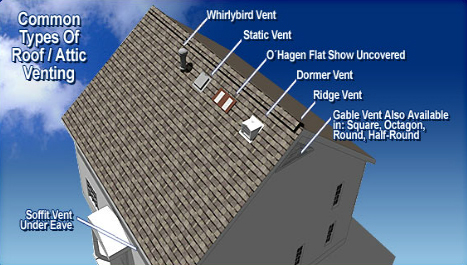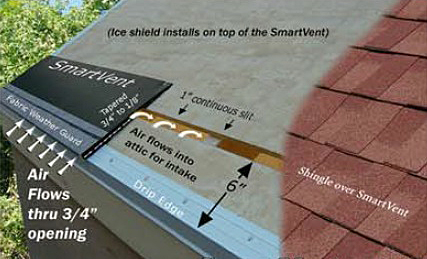Ventilation

Ventilation is crucial to the life and effectiveness of every roofing system. Vapors and condensation can cripple R-values and encourage hidden decay in the building structure. Premier Home Renovations’s trained staff will recommend a system that performs where you see it, and where you can’t. It is estimated that 9 out of 10 homes in North America do not have proper attic ventilation. Why? Because most people are unaware that attic ventilation can impact the longevity of their entire home! For example, in the summer, an improperly ventilated attic can cause heat to build in excess of 160°F. This superheated air eventually penetrates the ceiling insulation into the living area below.
Types of Damage that can Result Include:
- Premature aging of your roofing system (“fried” shingles)
- Warping, cracking, or breaking down of wood framing
- Damage to siding, exterior or interior paint, and wallpaper
- Higher energy costs
A properly ventilated attic can help reduce the load on your air conditioner by moving the superheated air out of your attic before it builds up and causes damage. In the winter, various household appliances, bathtubs, showers, and cooking vapors can contribute to excess moisture build-up. Improperly ventilated attics will allow this moisture to collect and cling to the underside of the roof. There, it will condense and fall, soaking the attic insulation and reducing its efficiency
Additional structural damage can include:
- Roof deck warping and rotting of the wood frame
- Mildew growth
- Buckling of shingles and felt
Proper attic ventilation systems allow a continuous flow of outside air through the attic, protecting the efficiency of the insulation and helping to lower temperatures in the living space. It consists of a balance between air intake (at your eaves or soffits) and air exhaust (at or near your roof ridge).
The FHA (Federal Housing Administration) recommends a minimum of at least 1 square foot of attic ventilation (both intake and exhaust) for every 300 square feet of attic space. For example, if your attic is 900 square feet, you need a total of 3 square feet of ventilation. This amount is generally divided equally between intake and exhaust ventilation (i.e., 11/2 feet of each), to insure proper airflow through the attic.
Our Solution: The SmartVent Ventilation System
A Total Attic Ventilation System

SmartVent is a tapered, under shingle plastic product designed for installation along the soffit edge of the roof or the facing edge of dormer rakes and goes virtually unnoticed. It allows air to flow freely through the 1″ roof decking slit providing more than adequate soffit ventilation to maximize ridge vent effectiveness. This is extremely important since most ridge vent products require an equal amount of ventilation at the soffit in order to work properly. SmartVent, when used at both soffits, has a total NFA rating of 18 sq. in. (or 9 sq. in. on each side of a standard gable roof).



